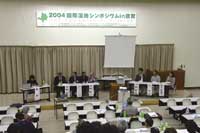
Major Activities of JAWAN
 Wetland Surveys Wetland Surveys
Determining a wetland's status on the basis of scientific data about its inhabitants is important when trying to protect it. JAWAN is putting energy into research on the migrations of shorebirds, wetland dwelling birds that often use tidal flats.
Shorebird counts: From 1996 to 1998, JAWAN carried out national shorebird counts with the cooperation of other NGOs and birdwatchers. From 2003, we have been cooperating with World Wide Fund for Nature Japan in surveying shorebirds, etc. for the Ministry of the Environment project for monitoring important habitat sites (Monitoring Site 1000).
Migration Studies: From 1996, JAWAN has been working with scientists, environmental activists, government officials and others in Japan and in countries along shorebirds' migratory routes to learn more about their migrations by gathering and exchanging information from observations of small colored leg flags attached at shorebirds site on the flyway.
Breeding ground surveys: Since 1999, surveys of shorebird breeding grounds and migrations focusing on Dunlin and Spoonbilled Sandpiper have been conducted with the cooperation of scientists, NGOs and others in Russia, the United States and Korea.
These surveys are also part of an international activity aimed at protecting waterbird flyways in the East Asia/Australasia region.
Working to influence the government and other organizations
JAWAN seeks opportunities to talk to, exchange opinions with, and make
suggestions to the Ministry of the Environment and local governments to
encourage them to reflect in their policy and practices the concepts of
wetland conservation and wise use as elaborated in the international Ramsar
Convention on Wetlands of International Importance, and in resolutions
and guidelines adopted by the Conferences of the Parties to this Convention.
In preparation for the 9th Ramsar Conference (CoP9), JAWAN submitted opinion
statements on Japan's national report, and on the selection of sites for
the Ramsar List of Wetlands of International Importance.
In our opinion statement on site selection, JAWAN suggested that Japan should aim for a goal of 100 Ramsar sites by CoP16 in 2026, and we hope to make this mid-term goal one of the main objectives of our movement in future. We are also calling for conservation of a network of wetlands in Japan and the Asian region and a variety of specific policy measures for achieving wise use of wetlands. No wetland exists in isolation, but in a network of wetlands linked together by the water cycle of its home river basin.
Networks of wetlands are also needed to secure sites along the flyways
of migratory birds. Conservation must apply not only to Ramsar sites, but
Ramsar sites can act as centerpieces for networks of related wetlands,
and conservation measures should be designed to protect these networks
in their entirety.
To achieve the mid-term goal of designating 100 Ramsar sites in Japan and
conserving their networks of related wetlands, everyone concerned with
protecting both existing Ramsar sites and other wetlands around the country
need to work together based on a common awareness. JAWAN works with a wide
variety of organizations and groups to encourage this kind of awareness.
Education and Public Awareness
The Ramsar Convention recognizes that it is vital to use every opportunity
available to communicate the value of wetlands to as many people as possible
in an easily comprehensible manner in order to achieve wetland conservation
and wise use. Many studies and information sources are available on methods
for pursuing education and public awareness. JAWAN supports a variety of
educational activities around the country.
Wetland Day in Japan: The date of April 14th commemorates the day in 1997 that Isahaya Bay's tidal flat wetland was closed off from the sea by a national land reclamation project. JAWAN and other NGOs have taken this day as “Wetland Day” in Japan, and every year a national wetland conservation campaign centers on this date. Nature conservation groups around the country participate by holding field trips and study meetings.
 The International Wetland Symposium: JAWAN held its first International Wetland Symposium in 1991. Leading domestic and international wetland experts are invited to speak, discussions of the most pressing wetland topics of the year are held, and the concepts of wetland conservation and wise use explored. In 2004, the symposium was held in Tsuruga City, site of Nakaikemi Mire; invited were a leading British mire wetland expert, representatives of the Ministry of the Environment and Tsuruga City, and many others involved with Nakaikemi and other wetlands around Japan. A statement calling for designation of Nakaikemi to the Ramsar List was adopted. The International Wetland Symposium: JAWAN held its first International Wetland Symposium in 1991. Leading domestic and international wetland experts are invited to speak, discussions of the most pressing wetland topics of the year are held, and the concepts of wetland conservation and wise use explored. In 2004, the symposium was held in Tsuruga City, site of Nakaikemi Mire; invited were a leading British mire wetland expert, representatives of the Ministry of the Environment and Tsuruga City, and many others involved with Nakaikemi and other wetlands around Japan. A statement calling for designation of Nakaikemi to the Ramsar List was adopted.
Translation and dissemination of information on the Ramsar Convention: To ensure that resolutions and other documents coming out of the Ramsar
Conferences of the Parties are put to use in furthering the conservation
and wise use of wetlands in Japan, JAWAN has cooperated with the Ministry
of the Environment in translating them into Japanese. JAWAN also holds
study meetings to explain the resolutions and guidelines in a way that
non-experts can understand.
Publishing information through the JAWAN newsletter and website
|